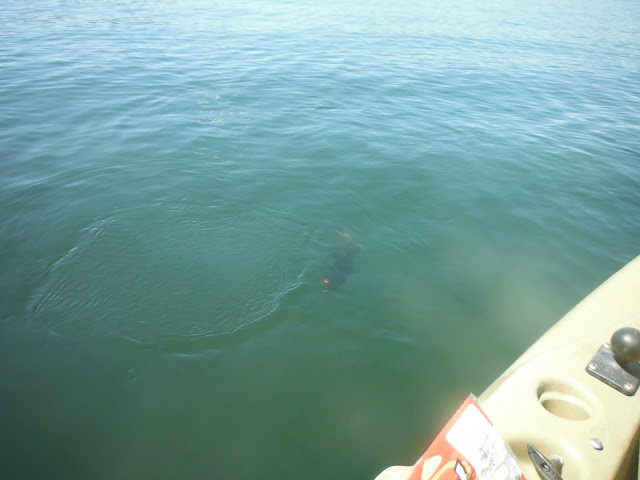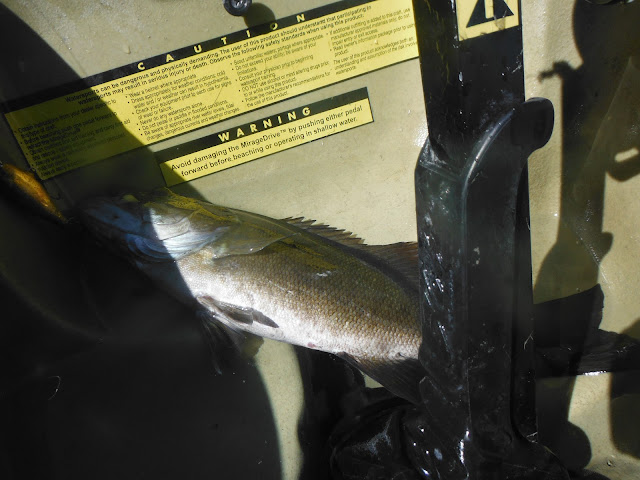 |
| Early spring on Lake Mahopac, NY |
 |
| The first morning yielded several quality smallmouths. |
 |
| Water clarity of about 5' on Mahopac. |
Some bass fishermen are smallmouth snobs. With the leaping ability of a salmon and the dogged attitude of a tautog, it is easy to see why someone could get hooked on these brown members of the bass family. In addition to providing great shallow water action along structure and dropoff's in the early spring, the smallies become almost semi-pelagic when the water becomes warm foraging on bait schools of baitfish in deep, open water.
For many years, I had a row boat on Cross River Reservoir in nearby Westchester County. Every spring, the pre-spawn smallmouth bass fishing would light up beginning in the last week of April and ending around the second week of May, when the bass would go on the spawn. During this time, the smallmouths schooled up tightly along dropoffs and fed heavily in anticipation of the spawn.
With lousy morning tides on Long Island, I decided to venture north to Westchester County to target pre-spawn smallmouths on Lake Mahopac. Typical of the area, Mahopac is a deep and rocky lake nestled in the hills of the Hudson Valley. There are several excellent smallmouth bass waters in a chain of lakes and impoundments in the higher elevation areas in downstate New York beginning with Mahpac moving east to similar smallmouth fisheries Cross River Reservoir and Sodum. The chains of lakes extend to western Connecticut with quality fisheries in Candlewood and Squantz.
Lake Mahopac is almost 600 acres and located closest to the Hudson River. Despite the size, I found I could easily cover almost the entire lake in a 3 - 4 hour trip. The two large islands make it a smaller lake.
I launched on Saturday morning at 9 am and fished until 12 pm. During that time, I caught 11 smallmouths from 15" to 21". In the mix were two 19" smallmouths as well and several that were around 17". I explored almost the entire lake from my kayak, and casted or trolled a good length of the shoreline and islands.
The smallmouths didn't appear to be on their beds yet. Everything I caught looked to be pre-spawn. These smallmouths were weighed down by their fat bellies when they went airborne after pulverizing my plug.
Small crankbaits were the order of the day. Trolling was the best method. Success was all about banging deep diving crankbaits into the rocks on the bottom. If the crankbait wasn't getting stuck, I wasn't hooking up consistently with smallmouths. The bass forage heavily on crawfish in Mahopac and orange was the magic color, out-producing minnow colors about 2:1.
 I caught most of my fish in about 12', which was as deep as my crankbaits would run. The smallmouths were holding right on the edge of steep drop-offs, as close to the steep sloping shoreline as possible without getting too shallow. It looked like they were waiting below the edge for a quick meal. The fish were mostly schooled up and I found a nice school, and kept trolling back and forth. The fish were aggressive and hit about every pass. Eventually, I moved on and found a nice rocky flat and fished 4' - 8' and caught a few more casting.
I caught most of my fish in about 12', which was as deep as my crankbaits would run. The smallmouths were holding right on the edge of steep drop-offs, as close to the steep sloping shoreline as possible without getting too shallow. It looked like they were waiting below the edge for a quick meal. The fish were mostly schooled up and I found a nice school, and kept trolling back and forth. The fish were aggressive and hit about every pass. Eventually, I moved on and found a nice rocky flat and fished 4' - 8' and caught a few more casting.On the way back to the launch, I found a submerged island that extended onto a big flat. While trolling, I hooked into a huge smallmouth that fought me for a few seconds and broke my 8lb flourocarbon. I would have really liked to see that fish. Unless I snagged a carp, it was likely an oversized smallmouth.
I ended the day catching a 17" smallie off the same structure and called it a morning at noon to make the one hour drive back to Long Island.
I got a later start the second day and fished from 12 pm to 3 pm. The school of smallmouths that I had found the prior day wasn't holding in the same area, and I could pull no smallmouths off the spot. I moved around considerably and had no success trolling. My only fish were caught casting crankbaits at the shoreline and fallen timber. A good amount of smallmouths were holding on the timber. The others were holding right on the edge of the dropoff, and often I could see the bass come off from the depths to the shallows and take the crankbait.
 I caught fish all over the lake, but it was a slow pick with smaller fish and my biggest smallmouths of the day were 15" and 17". I caught 9 total smallmouths and a big 14" yellow perch.
I caught fish all over the lake, but it was a slow pick with smaller fish and my biggest smallmouths of the day were 15" and 17". I caught 9 total smallmouths and a big 14" yellow perch.The 22" smallmouth I caught on Saturday was my largest since 2008 and my third qualifying species for the New York State Angler Achievement Award. Once I hooked up, I knew I was into a very good fish. It gave me a dogged fight and quickly took drag as the fish ran deep and away from the boat. There is nothing like catching a big smallmouth - they fight like tog and jump like salmon.
During the 1990s, I travelled near and wide to fish for smallmouth bass. I have fished most of the better fisheries in NY, VT, and NH. The three most productive lakes I fished were Lake Memphremagog, Lake Oneida, and Lake Winnepesaukie. The best fishery by far was Lake Memphremagog. During the peak, the average sized smallmouth was 3 lbs and they were numerous, with a very good chance of catching some 5 lb - 7 lb smallmouths as well. I was impressed by the fishery at Mahopac. The quality and quantity of smallmouths reminded me of Lake Oneida based on the excellent fishing Saturday. The second day wasn't near that quality, but still quite productive and certainly on par with nearby Cross River Reservoir.
All fish caught and released. Here are some pics. For once, I forgot my measuring board on the first morning so had to improvise with the paddle for measurement.
 |
| This 14.5" yellow perch would have qualified for the NYS Angler Achievement Award but I already caught a qualifying perch earlier this season. |















